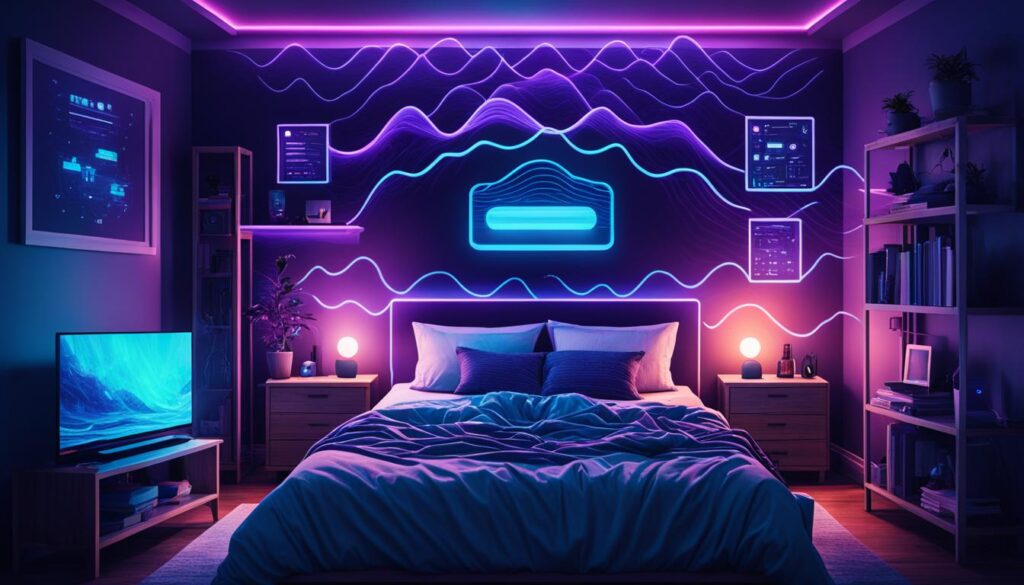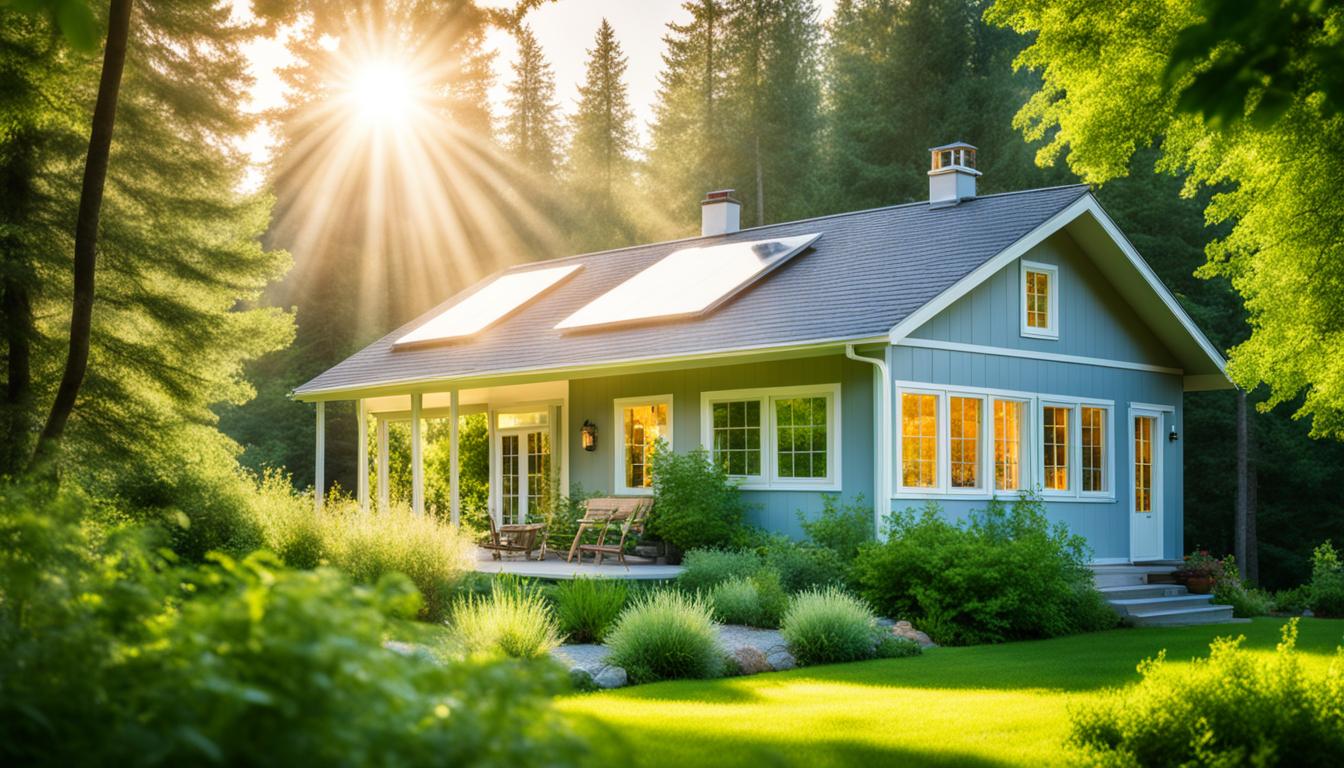Disclosure: This Post Contains Affiliate Links; We earn a commission on purchases.
Sleep is essential for our overall health and well-being. However, electromagnetic field (EMF) exposure in the bedroom can negatively impact our sleep quality and health. EMF radiation from various sources like power lines, electrical wiring, appliances, and wireless devices can interfere with melatonin production and disrupt our natural sleep-wake cycle, leading to restless nights and daytime fatigue.
To create a low EMF sleeping environment and improve your sleep, it’s important to take steps to reduce EMF exposure in your bedroom. While it’s impossible to completely eliminate EMF, there are effective solutions and strategies to minimize exposure and create a safe and peaceful sleeping space.
Key Takeaways:
- Create a low electromagnetic field (EMF) environment in your bedroom to promote better sleep.
- Identify and address common sources of EMF, such as power lines, electrical wiring, appliances, and wireless devices.
- Be aware of the health effects of EMF exposure, including sleep disruption, reduced melatonin production, and disrupted circadian rhythm.
- Minimize the use of wireless devices and consider turning off the WiFi router at night to reduce radiofrequency EMF exposure.
- Reduce electric fields in the bedroom by moving electronic devices away from the bed and removing unnecessary ones.
The Health Effects of EMF Exposure
Exposure to EMF radiation can have significant effects on our health, including interference with our sleep patterns. The negative health effects of EMF exposure are well-documented and include suppression of the immune system and an increased risk of cancer.
One of the ways EMF radiation can disrupt our sleep is by interfering with the production of melatonin, a hormone that regulates our sleep-wake cycle. Melatonin is crucial for promoting healthy sleep, and any disruption to its production can lead to sleep disturbances.
In addition to melatonin disruption, EMF radiation can also disrupt our circadian rhythm. Our circadian rhythm is our internal clock that regulates our sleep and wakefulness throughout the day. Exposure to EMF radiation can throw off this rhythm, making it more difficult to fall asleep and stay asleep.
A study has found that exposure to magnetic fields, a common type of EMF, can decrease sleep efficiency, reduce REM sleep, and disrupt overall sleep patterns. This highlights the need to address EMF exposure, especially in the bedroom where we spend a significant amount of time sleeping.
To illustrate the effects of EMF exposure on sleep, refer to the table below:
| Sleep Parameter | Effect of EMF Exposure |
|---|---|
| Sleep Efficiency | Decreased |
| REM Sleep | Reduced |
| Sleep Patterns | Disrupted |
As shown in the table, EMF exposure can significantly impact sleep efficiency, REM sleep, and the overall quality of our sleep. It is essential to address and minimize EMF exposure in the bedroom to promote better sleep and overall health.
Common Sources of EMF in the Bedroom
The bedroom is a haven for relaxation and rest, but it is also a place where we are exposed to electromagnetic fields (EMF) from various sources. Understanding these sources is essential in addressing and reducing EMF exposure in the bedroom to create a healthier environment for sleep.
EMF sources in the bedroom include:
- Power Lines: Power lines near or passing by your bedroom can emit EMF that extends into your living space. These power lines are a common source of magnetic fields in your bedroom.
- Electrical Wiring: The electrical wiring within the walls of your bedroom also produces EMF. Electric fields emanate from the wiring, creating a constant exposure in your sleeping area.
- Appliances: Common household appliances such as refrigerators, televisions, bedside lamps, and electric blankets can generate both electric and magnetic fields, contributing to EMF exposure in your bedroom.
- Wireless Devices: The widespread use of wireless devices like cell phones, tablets, WiFi routers, and smart meters introduces radiofrequency (RF) EMF into your bedroom. These wireless devices emit RF-EMF, a type of EMF that poses its own health risks.
To illustrate the sources of EMF in the bedroom, refer to the table below:
| EMF Sources | Type of EMF |
|---|---|
| Power Lines | Magnetic Fields |
| Electrical Wiring | Electric Fields |
| Appliances | Electric and Magnetic Fields |
| Wireless Devices | RF-EMF (Radiofrequency Electromagnetic Fields) |
By recognizing these common sources of EMF in the bedroom, you can take steps to reduce exposure and create a more EMF-safe sleeping environment.
The Impact of Electric Fields in the Bedroom
Electric fields play a significant role in the presence of EMF in the bedroom. These fields are generated by electrical wires installed in the walls and can extend up to 6-8 feet from the wires. This means that even in an average-sized bedroom, it is nearly impossible to escape electric fields emanating from the wiring.
In addition to electrical wiring, several devices commonly found in bedrooms contribute to the accumulation of electric fields. Table lamps, alarm clocks, and cell phone chargers, for example, all emit electric fields as part of their normal operation. The combined presence of these devices can lead to heightened levels of electric fields in the bedroom.
It is crucial to recognize that electric fields are closely linked to EMF exposure and its potential health effects. The more electric fields present in an environment, the higher the risk of EMF exposure. Consequently, this can have a significant impact on our well-being, including potential effects on sleep and overall health.
To better understand the impact of electric fields, it’s important to recognize the role they play in the overall EMF exposure in our bedrooms. By addressing the sources of electric fields and implementing measures to reduce their presence, we can create a healthier and more harmonious sleeping environment.
Electric Fields in the Bedroom Checklist
- Ensure electrical wiring is properly grounded to minimize electric field generation.
- Consider relocating bedside electrical devices away from the sleeping area to reduce exposure.
- Use battery-operated or low EMF alternatives for alarm clocks and other electronic devices.
- Unplug electrical devices when not in use to minimize electric fields.
- Consider using an EMF shield or barrier to mitigate electric fields emitted by electrical wiring.
By following these recommendations and taking proactive steps to reduce electric fields in the bedroom, it is possible to minimize EMF exposure and promote a healthier sleeping environment.
| Source of Electric Field | Potential EMF Exposure |
|---|---|
| Electrical wiring in walls | High |
| Table lamps | Moderate |
| Alarm clocks | Low |
| Cell phone chargers | Low |
The Dangers of Radiofrequency EMF in the Bedroom
Radiofrequency (RF) electromagnetic fields (EMF) pose significant dangers when present in the bedroom. RF-EMF is a type of EMF that is especially prevalent due to the use of wireless devices in our modern lives. These devices, including cell phones, WiFi routers, and smart meters, emit RF-EMF, increasing our exposure to this type of electromagnetic radiation.
While RF-EMF is just one type of EMF, it is important to acknowledge that other sources contribute to overall exposure and potential health risks. However, RF-EMF is particularly concerning due to its widespread use and the close proximity of wireless devices in our bedrooms.
Research has linked RF-EMF exposure to various health issues. Prolonged exposure to RF-EMF can have adverse effects on our body, including:
- Increased risk of cancer
- Disrupted sleep patterns
- Altered melatonin production
- Impaired immune system function
Reducing RF-EMF exposure in the bedroom is crucial for promoting a healthier sleeping environment. Minimizing the use of wireless gadgets, such as keeping cell phones and WiFi routers away from the sleeping area or turning them off at night, can help mitigate RF-EMF exposure. Creating a distance between wireless devices and the body can significantly reduce electromagnetic radiation absorption.
By being aware of the dangers associated with RF-EMF and taking proactive steps to minimize exposure, we can promote better sleep and overall well-being in our bedrooms.

The Effects of Dirty Electricity in the Bedroom
When it comes to reducing EMF exposure in the bedroom, one important consideration is dirty electricity, also known as electricity pollution. Dirty electricity refers to irregularities or distortions in the normal electrical current within a wiring system, which can contribute to increased EMF exposure and potential health risks.
Appliances and energy-saving devices are common sources of dirty electricity. These devices can create electrical distortions that extend about 6-8 feet into the living space, affecting the bedroom as well. This means that even when you’re trying to create a safe haven for sleep, you may still be exposed to elevated levels of EMF.
Reducing dirty electricity in the bedroom is crucial for creating a low EMF environment. By taking steps to minimize the use of appliances and energy-saving devices that contribute to dirty electricity, you can reduce your overall EMF exposure. Consider unplugging devices when not in use or using surge protectors with built-in filters to mitigate dirty electricity.
Furthermore, it’s helpful to conduct an audit of your bedroom’s electrical system to identify and address any potential sources of dirty electricity. Consulting with a professional electrician or utilizing EMF meters can provide valuable insights into the presence of dirty electricity and guide you in taking appropriate measures to mitigate it.
By reducing dirty electricity, you can create a safer and healthier sleeping environment, minimizing the potential health risks associated with EMF exposure in the bedroom.
Practical Tips for Reducing EMF in the Bedroom
Creating a low EMF sleeping environment is essential for reducing EMF exposure and promoting better sleep. Here are some practical tips to help you reduce EMF in your bedroom:
1. Turn off the WiFi router at night or use a timer
WiFi routers emit significant amounts of EMF, even when not in use. To minimize exposure, turn off your WiFi router at night or use a timer to automatically shut it off during sleep hours.
2. Keep electronic devices outside the bedroom or in airplane mode
Electronic devices such as cell phones, tablets, and laptops emit EMF. Keep these devices outside the bedroom or switch them to airplane mode to reduce EMF exposure while you sleep.
3. Avoid the use of electric blankets
Electric blankets generate electric fields that can increase EMF exposure. Instead, opt for natural fiber blankets or a hot water bottle to keep warm during colder nights.
4. Move electronics away from the bed or remove them from the bedroom
Electronics like alarm clocks, table lamps, and charging stations emit EMF. Keep them as far away from the bed as possible or remove them from the bedroom altogether to minimize exposure.
5. Consider the use of EMF mitigating devices
EMF meters and shields can help mitigate EMF exposure in the bedroom. These devices measure and block EMF, providing an additional layer of protection. Consider using them to create a low EMF sleeping environment.

| Tips for Reducing EMF in the Bedroom |
|---|
| Turn off the WiFi router at night or use a timer |
| Keep electronic devices outside the bedroom or in airplane mode |
| Avoid the use of electric blankets |
| Move electronics away from the bed or remove them from the bedroom |
| Consider the use of EMF mitigating devices |
The Importance of EMF Awareness and Education
Increasing awareness and education about EMF exposure and its potential health risks is crucial. Many individuals are unaware of the sources of EMF in their environment and the impact it can have on their health, especially in the bedroom where we spend a significant amount of time sleeping. By promoting EMF safety and providing information on ways to reduce exposure, we can empower individuals to make informed choices and take steps to create a low EMF sleeping environment.
EMF awareness involves understanding the sources of EMF in our surroundings and recognizing the health risks associated with prolonged exposure. Through education, individuals can learn about the various sources of EMF in the bedroom, such as power lines, electrical wiring, appliances, and wireless devices. By knowing these sources, people can become more conscious of their exposure and take appropriate measures to minimize it.
When it comes to promoting EMF safety, it is essential to educate individuals about the potential health risks of EMF exposure. Scientific studies have linked EMF radiation to sleep disruption, melatonin production interference, and circadian rhythm disruption. By disseminating this information, we can raise awareness about the importance of reducing EMF exposure, especially in the sleeping environment.
The Benefits of EMF Awareness and Education
EMF awareness and education have several significant benefits:
- Improved Health: By understanding the potential health risks associated with prolonged EMF exposure, individuals can take proactive measures to reduce their exposure and maintain better overall health.
- Better Sleep: Awareness of how EMF can disrupt sleep patterns allows individuals to create a sleep-friendly environment by minimizing exposure to EMF sources in the bedroom.
- Informed Choices: Education empowers individuals to make informed decisions when purchasing and using electronic devices, considering the potential EMF emissions.
- Peace of Mind: Knowing the steps taken to reduce EMF exposure provides individuals with peace of mind, ensuring they are actively safeguarding their health and well-being.
Overall, increasing EMF awareness and education is crucial for individuals to understand the potential health risks associated with exposure. By promoting EMF safety, we can empower individuals to make informed choices and take steps to create a low EMF sleeping environment, ensuring better sleep and improved overall well-being.
Conclusion
Creating a low EMF sleeping environment is crucial for improving sleep quality and promoting overall health. Numerous studies have linked EMF exposure in the bedroom to sleep disruption and negative health effects. By being informed about the sources of EMF and taking practical steps to reduce exposure, individuals can create a healthier and safer sleeping environment.
Implementing strategies such as turning off the WiFi at night, keeping electronic devices out of the bedroom, and using EMF mitigating devices can significantly reduce EMF exposure. These actions contribute to creating a low EMF sleeping environment, which can result in better sleep quality and improved overall well-being.
Additionally, it is essential to educate ourselves and others about EMF safety. By increasing awareness and understanding of the potential health risks associated with EMF exposure, we can make informed choices and take necessary precautions. Promoting the importance of EMF reduction and providing information on creating a low EMF sleeping environment empowers individuals to prioritize their sleep health and make positive changes for themselves and their loved ones.
Source Links
- https://www.latexforless.com/blogs/latex-for-less-blog/how-to-reduce-emfs-in-your-bedroom
- https://www.getgreenbewell.com/reduce-emfs-in-your-bedroom/
- https://www.shieldyourbody.com/emf-bedroom/

Subscribe to Our Newsletter










